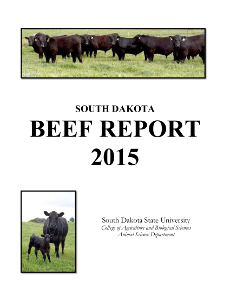Document Type
Report
Report Number
2015-9
Publication Date
2015
Summary
The β–adrenergic agonist zilpaterol hydrochloride (ZH) affects skeletal muscle growth, but little is known if this response is influenced by differences in genetic background of cattle. The objective of this study was to determine the effects of ZH on growth, carcass characteristics and production economic responses of Angus-sired (ANG) and SimAngus-sired (SIMANG) steers. Pens within each block × breed composition were randomly assigned to either ZH (8.3 ppm of DM; fed for the final 20 d before slaughter) or control (CON; 0 ppm ZH). Steers were ultrasounded before ZH inclusion and following withdrawal to determine the influence of ZH on change in ribeye area (REA), fat thickness and percent intramuscular fat (IMF). Carcass and feedlot performance data were collected and used to determine breed composition and ZH effects on economic responses. The interaction of breed composition × ZH had no influence on measured responses. Breed composition did not influence change in ultrasound measurements during the ZH feeding period or feedlot performance. Carcasses from SIMANG steers had larger REA and improved YG, while ANG steers had increased marbling scores. SimAngus-sired steers produced a greater percentage of YG 2 and a lower percentage of YG 3 carcasses than ANG steers. A greater proportion of ANG carcasses were classified as upper 2/3 Choice while a greater proportion of SIMANG carcasses were included in the lower 1/3 Choice designation. Carcass value per cwt was greater for ANG compared to SIMANG carcasses while other economic responses were similar. Feeding ZH improved ADG, YG, and REA and resulted in increased YG 2 carcasses. Total carcass value was greater for ZH compared to CON. While CON had increased IMF during ZH feeding, this did not manifest into differences in QG. Breed composition influenced carcass grid premiums, but not overall carcass value. Feeding ZH improved carcass value by increasing HCW. Responses among breed composition were as expected for ANG vs SIMANG cattle types. The resultant economic effect was that grid premiums for higher-grading ANG cattle were offset by larger HCW for SIMANG, leading to similar overall carcass values. Finally, the influence of ZH on growth and carcass traits was as expected with increased carcass value being realized through heavier HCW.
Number of Pages
7
Format
application/pdf
Language
en
Publisher
South Dakota State University
Rights
Copyright © 2015 South Dakota State University
Recommended Citation
Fulton, J.O.; Olson, K.C.; Kincheloe, J.J.; Harty, A.A.; Luebbe, M.K.; Underwood, K.R.; Scamlin, S.M.; and Blair, A.D., "Effects of Zilpaterol Hydrochloride Supplementation on Growth Performance,Carcass Characteristics and Production Economics of SteersDiffering in Breed Composition" (2015). South Dakota Beef Report, 2015. 10.
https://openprairie.sdstate.edu/sd_beefreport_2015/10

